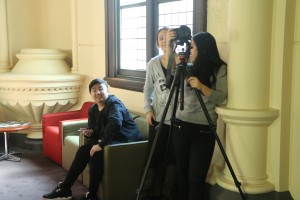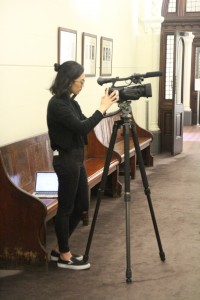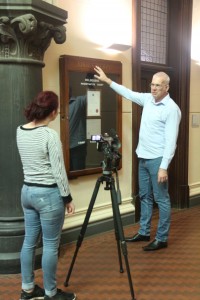Title: Mrs. Baines goes to Court
- Format: Mixed Media, Stop Motion Film, Personal Documentary – Have narrative over the top
- Proposed Length: 1 ½ Minutes to 2 Minutes
Synopsis – what ‘happens’
- The Forgotten: Highlight a story of the magistrate court that has been forgotten, not heard a lot about narrated by myself
- The various perspectives: Main Character is Jennie Baines (Part of the Suffragette Movement in the UK and Melbourne)
Focus on her court case on Tuesday March 18th 1919 (Will reference to her the ones leading up to it as well)
- She was arrested with Richard Long for exhibiting a red flag (International sign for socialism) at the demonstration/ “meeting” in Melbourne. She refused to pay the fine or sign the bond this lead to the first reported prisoner in Australia to go on a hunger strike
- Telling the story from various perspectives (Of her supporters, the media and her family) of the court case of Jennie Baines in 1919
- Personal: Tie it in with my personal opinions of the significance of it and the relation to our social, political situation as of today
Why
Although the aspects of the Catherine and the case that interested me was the perspective of the female thief and criminal. What her intentions were behind it. My original concept was for an actor as Catherine Smith to tell the story and then have the characters, locations superimposed in the screen as well. Visual “Ghosts”
However not just a retelling of the story was what I wanted to show. The second story provided more of a social context and more resources to be mined as well. I found it hard to find court cases and there were the three prominent ones of Ned Kelly, Squizzy Taylor and the Eureka Stockade. Although I did want to tell a story that was less well known. I come across Jennie Baine’s story, as it was part of an online Melbourne Walking Tour. She was reported to be the first person ever to go on a hunger strike in Australia. I think she had a very unique perspective like Catherine Smith on the what was happening at the time.
From the various approaches to space/place we have looked at so far WHICH concept does it most readily relate to?
It relates to place and memory and also what we remember and forget through history. When Professor Paul Gough came to his talk we were talking about the very topical issue of ANZAC day and forgotten soldiers. However I think it was interesting that a couple of days later I was talking to a friend who is a producer for a political radio show on SYN and they wanted to do a piece on the people who were forgotten, like women and indigenous people as well. Using the court room’s physical objects and matching that up with old photography to lead the story and ‘spark’, ‘relive’ the events of the past.
Inspiration
https://www.shortoftheweek.com/2014/06/04/gan-gan/
Stop motion film Gan Gan
The stop motion has that disorientating effect because time is moving so quickly – in the theme of forgotten and memory it has that same feeling of things slipping again
Blight: https://www.youtube.com/watch?v=yil33Hb9BpM
Explored the association between sound and image in a more abstract way
http://www.alfred-hitchcock-films.net/Themes/Double-Exposure-Theme.htm
Double Exposure Shot in The Wrong Man
The scene: https://www.youtube.com/watch?v=WUN5c6jtTvU
Sunrise – the women scene – From 2:27
https://www.youtube.com/watch?v=TyNE3Pfq-KM
Work so Far
Researched into Catherine Smith
– Mainly through Trove and PapersPast looking through old newspapers for clues
Went to the public records office
– Looking at old magistrate registries – although unsuccessful I learnt a lot about the process of it – more about which documents to book
More Research Into Jennie Baines
– Timeline her activity
– Looking at books online regarding the women’s suffrage movement
– Finding photos of her
Looking into Stop Motion equipment and method
– Equipment that I will need to use
Did a test run using my iPhone
Although it will be a different camera I still got a feel of how it might work and saw some problems that might come up
Test Shot #1 (Morning)
Other versions – this was just the best one so far
100 Shots = 20 seconds
Lighting
It’s flickering – Whichever camera I use needs to have auto exposure off to compensate for this
The room was dim – in the afternoon it could be better
All the lighting comes from the top as well which can make the bottom – where all the shots will be quite dark – wood all blending together when you get close up
Do I want to bring in my own lighting? To brighten it up and then colour grade it later
Camera Shake
I was using my iPhone without a tripod so it was shaky
However moving a tripod for a tracking shot might not be able to get the minimal movement needed – I think for the tracking shots I will use a light weight camera on a tripod stick
Although in the final I think a little bit of shakiness or distortion with the tracking shots will add to the effect of it
Focusing
Auto focus off
Timeline
| Week |
Activity |
| April
20th – 26th |
Friday: PITCH
Saturday – More research – finding key points to highlight in the story
Contacting Historians if need be
Sunday – Scripting along side the Storyboard
– Will I need actors?
– What locations? Time of day |
| 27th – 3rd May |
Tuesday 28th
Already booked to go in: PRO – Research
Thursday 30th
Scripting, Storyboard |
| May
4th – 10th |
Saturday 9th & 10th
Filming at the Court |
| 11th – 17th |
Thursday 14th
Filming outside shots and other locations
Saturday 16th & 17th
Filming (Not at the court – other shots that I need) |
| 18th – 24th |
Tuesday 19th
Editing/Music Selection
Sunday 24th
Editing |
| 25th – 31st |
Thursday, Sat, Sun
Editing |
June
1st – 7th |
Friday 5th: PROJECT DUE |
| 8th – 14th |
Friday 11th: PRESENTATION |
Any aspects you need help with (ie class in using a particular software, access to particular equipment etc)
I will be shooting with a DSLR Canon 60D, some people even use webcams for beginners however I want a better quality
“Canon EOS cameras with live view are probably the best choice for shooting stop motion animation. They have a large, high-quality live view image that can simulate exposure settings. And they don’t seem to suffer from overheating the way some other cameras do.”
Handheld – Canon HV40, Sony HDR-HC7
Tripod
Editing – Adobe Premiere
24 second frame rate
Colour grading




